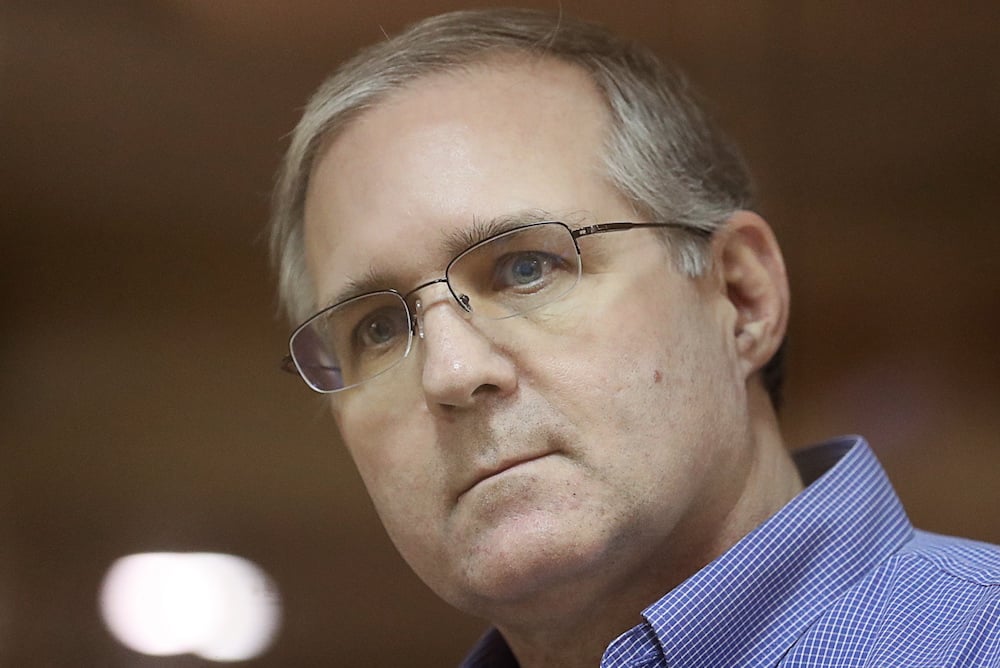
What is it about art and espionage lately?
Last year, artnet News reported that a Chinese security guard employed by Christie’s, who once guarded the record-setting $450 million Salvator Mundi by Leonardo da Vinci, turned out to be a former CIA officer suspected of leaking classified information to China.
Circled, Jerry Chun Shing Lee works security at the unveiling of Leonardo da Vinci’s Salvator Mundi on October 15, 2017, at the Christie’s showroom in Hong Kong. Photo: Anthony Wallace/AFP/Getty Images.
Now, in two separate investigations involving allegations of attempted murder and espionage, three suspects claim they were just in town for the art and architecture.
In late December, former US Marine Paul Whelan was nabbed by Russian authorities in Moscow moments after he received a flash drive packed with classified information, according to Rosbalt, a Russian news agency with ties to the state. The agency reports that the drive contained a full list of the names of employees of a secret Russian security agency. Further complicating matters for Whelan is his complicated citizen record: he holds passports from the US, Canada, Britain, and Ireland “by birth and through a patchwork of ancestors,” according to the New York Times.
Whelan’s explanation?
“Paul actually was meant to receive information that was not classified from an individual,” his lawyer, Vladimir A. Zherebenkov, told the New York Times. “These were cultural things—a trip to a cathedral, Paul’s holiday. But as it turned out, it contained classified information.”
Russian authorities are not buying it. Foreign minister Sergey V. Lavrov said Whelan was “caught red-handed.”
Yesterday, a Moscow judge denied Whelan’s request for bail and ordered him held in the city’s Lefortovo Prison for at least a month. If Whelan is convicted of espionage, he faces up to 20 years in jail.
The two suspected Russian spies identified as Alexander Petrov and Ruslan Boshirov. Photo by Scotland Yard/Handout/Anadolu Agency/Getty Images.
Meanwhile, this past fall, two Russian men identified by British officials as suspects in the attempted poisoning murder of former Russian intelligence officer Sergei Skripal in Salisbury, denied the claims, suggesting they just happened to be in town at the time of the incident to see the city’s marvelous architectural landmarks.
The suspects, who closely resemble two men shown in security stills released by British authorities, appeared on Russia’s state-funded television channel, RT, claiming their visit to the “wonderful” English town was prompted by their interest in Gothic architecture and Salisbury’s famous cathedral.
Salisbury Cathedral pictured in 2016. Courtesy WyrdLight.com/Wikicommons.
“Our friends had been suggesting for a long time that we visit this wonderful town,” said one of the men, who identified himself as Alexander Petrov.
The other man, who identified himself as Ruslan Boshirov, said that he and Petrov visited Salisbury Cathedral, which he described in the interview as “famous not just in Europe, but in the whole world. It’s famous for its 123-metre spire, it’s famous for its clock, the first one [of its kind] ever created in the world, which is still working.” He is also quoted as saying: “We were just taking in the English gothic [style].”
Alexander Petrov and Ruslan Boshirov walking on a sidewalk in London on September 5, 2018. Photo by Scotland Yard / Handout/Anadolu Agency/Getty Images
Boshirov and Petrov visited Salisbury twice, on March 3 and 4, 2018. British police say the first visit was made to scope out the city ahead of the planned attack. Petrov insisted that the reason they returned was because they couldn’t handle the cold.
“We arrived in Salisbury on 3 March and tried to walk through the town, but we lasted for only half an hour because it was covered in snow,” he said. “We specifically went there [again] to see the Old Sarum [an ancient settlement near Salisbury], Stonehenge and the cathedral, and decided to finish this thing on 4 March.”
Despite their denials, the European Union officially sanctioned the two men on Monday, along with two others, instituting a travel ban and freezing their assets.